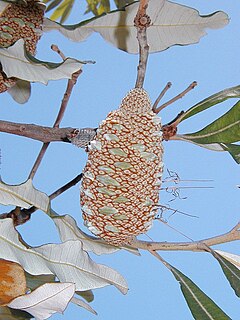
The Asian leaf turtle is a species of turtle found in Southeast Asia. They are quite common in the pet trade; their carapaces resemble that of a Cuora amboinensis hybrid.

Quercus dentata, also called Korean oak, Japanese emperor oak, also daimyo oak is a species of oak native to Japan, Korea and China. The name of the tree is often translated as "sweet oak" in English to distinguish it from Western varieties.

Banksia dentata, commonly known as the tropical banksia, is a species of tree in the genus Banksia. It occurs across northern Australia, southern New Guinea and the Aru Islands. Growing as a gnarled tree to 7 m (23 ft) high, it has large green leaves up to 22 cm (8.7 in) long with dentate (toothed) margins. The cylindrical yellow inflorescences, up to 13 cm (5.1 in) high, appear over the cooler months, attracting various species of honeyeaters, sunbirds, the sugar glider and a variety of insects. Flowers fall off the ageing spikes, which swell and develop follicles containing up to two viable seeds each.
The Field Elm cultivar Ulmus minor 'Albo-Dentata' first featured in the Baudriller nursery catalogue of 1880 as U. microphylla foliis albo-dentata. It was distributed by the Späth nursery of Berlin in the late 19th and early 20th century, as U. campestris microphylla fol. albo-dentatis.

The Sahel bush sparrow or bush petronia is a species of bird in the family Passeridae. It is found in Africa from Mauritania to Guinea and east to Eritrea and the south-western Arabian Peninsula in its natural habitats of dry savanna and subtropical or tropical dry shrubland.

Cyclemys is a genus of freshwater turtles, commonly referred to as Asian leaf turtles, from the family Geoemydidae. The genus occurs throughout Southeast and South Asia, and currently contains seven species.

The fascia dentata is the earliest stage of the hippocampal circuit. Its primary input is the perforant path from the superficial layers of entorhinal cortex. Its principal neurons are tiny granule cells which give rise to unmyelinated axons called the mossy fibers which project to the hilus and CA3. The fascia dentata of the rat contains approximately 1,000,000 granule cells. It receives feedback connections from mossy cells in the hilus at distant levels in the septal and temporal directions. The fascia dentata and the hilus together make up the dentate gyrus. As with all regions of the hippocampus, the dentate gyrus also receives GABAergic and cholinergic input from the medial septum and the diagonal band of Broca.
Phrissomini is a tribe of longhorn beetles of the Lamiinae subfamily. It was described by Thomson in 1860.
Pseudostixis is a genus of longhorn beetles of the subfamily Lamiinae, containing the following species:
Pseudostixis densepunctata is a species of beetle in the family Cerambycidae. It was described by Stephan von Breuning in 1936.
Pseudostixis griseostictica is a species of beetle in the family Cerambycidae. It was described by Stephan von Breuning in 1936.
Pseudostixis kivuensis is a species of beetle in the family Cerambycidae. It was described by Stephan von Breuning in 1936.
Pseudostixis marshalli is a species of beetle in the family Cerambycidae. It was described by Stephan von Breuning in 1936.
Pseudostixis proxima is a species of beetle in the family Cerambycidae. It was described by Stephan von Breuning in 1936.
Pseudostixis vicina is a species of beetle in the family Cerambycidae. It was described by Stephan von Breuning in 1936.
Pseudostixis basigranosa is a species of beetle in the family Cerambycidae. It was described by Stephan von Breuning in 1945.
Pseudostixis basilewskyi is a species of beetle in the family Cerambycidae. It was described by Stephan von Breuning in 1960.
Pseudostixis flavomarmorata is a species of beetle in the family Cerambycidae. It was described by Stephan von Breuning in 1964, originally as Pseudostixis flavomarmoratus. It is known from the Democratic Republic of the Congo.
Pseudostixis integra is a species of beetle in the family Cerambycidae. It was described by Stephan von Breuning.
Pseudostixis flavifrons is a species of beetle in the family Cerambycidae. It was described by Aurivillis in 1914, originally under the genus Stixis.






